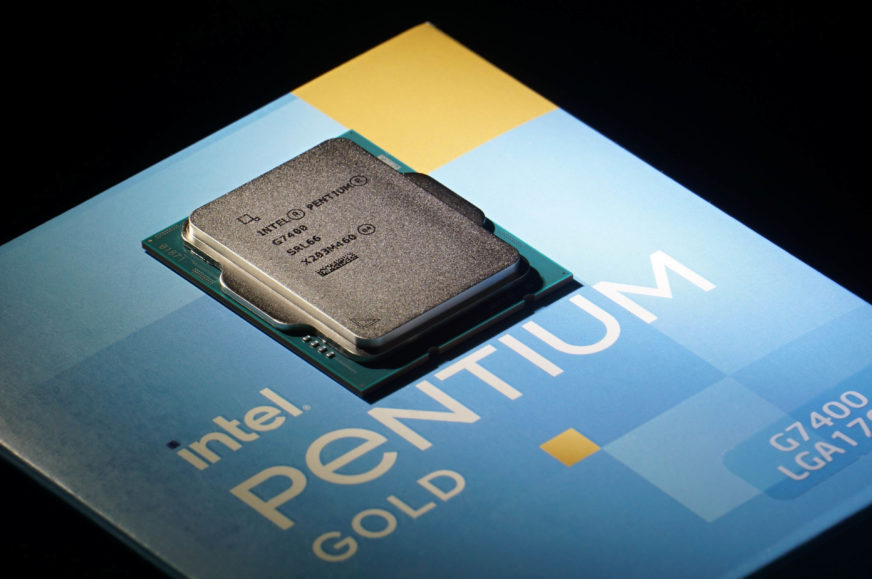Intel will keep offering dual-core processors
Last year, Intel announced the end of the once famous Celeron and Pentium brands that have since been relegated to the bottoms of lowend, with cheapest CPU lines no longer bearing any special name. Such E-Core-only “Intel Processors” have appeared in laptops, but desktop has note yet caught up with the rebranding – until now. Desktop “Intel processor” SKUs will however be based on the big cores. You’ll still only get dual-core, though.
According to the usually reliable Twitter source chi11eddog, Intel is preparing a new low-end desktop LGA 1700 platform model the for the third quarter, which will replace the current Pentium Gold G7400 that was part of the 12th generation “Alder Lake”. The 13th generation “Raptor Lake” hasn’t replaced it with anything yet, which is apparently to be changed now. According to chi11eddog, this new product might even belong to the 14th generation Raptor Lake Refresh, but that might be incorrect, as the refresh is not supposed to be out until October and the new low end processor should reportedly be on sale before then as said.
The name of this new low-end processor is Intel Processor 300 or just Intel 300. The number is probably meant to suggest positioning above the mobile “Intel Processor” models, which have the N100 and N200 designations. Those processors are quad-core, but they are based on the Alder Lake-N chip, which only contains “little” E-Cores. In contrast, the Intel 300 for desktop has two cores, but both are big P-Cores with the Golden Cove architecture and HT enabled, for a total of four threads.
Their clock speed, according to chi11eddog, is going to be 3.9 GHz. Turbo will again not be used as was the case with desktop Pentium (Gold) SKUs. The L3 cache is 6 MB and the processor is supposed to have a TDP of 46 W. We don’t know the price yet, but it might be the same as for the Pentium Gold G7400 (found from 2350 CZK in Czech Republic and often over 100 $ globally despite MSRP being lower, which makes it a rather bad deal). The new Intel 300 model is said to appear in stores in Q3 2023, which imply August or September launch.

The processor fits into the LGA 1700 socket and is most likely made from a six-core chip with H0 (6+0) stepping originally released in the Alder Lake CPU generation. So it will be severy cut down in this SKU. Intel can either use chips with multiple defects, or in absence of such silicon that is not good for anything else, the company will have to basically throw away additional healthy cores on these dies to make the Intel 300. Perhaps Intel counts on these dual-core models not selling much volume anymore (and the bad price of that Pentium G7400 Gold might actually suggest that).
A dual-core will still be enough for many common tasks these days, but such CPU setup is getting more and more archaic (now when Intel’s highest model now fields 8+16 cores). It would be good if these baseline processors got bumped up to a bit better configuration, particularly if Intel makes them from a six-core die anyway. Personally I might have preferred the mobile version with four little E-Cores, which wouldn’t be faster (it would even be slower in S tasks), but at least it would be low-power. The Alder Lake-N chip used in those mobile “Intel Processors” actually contains as many as eight E-Core cores physically, and with all those being enabled, it would definitely end up being a much more interesting than the a dual P-core Alder Lake derivative. But Intel isn’t using this 8C configuration in the low end right now, they’re only reserving it for more expensive SKUs branded as Core i3.
Unfortunately, the Alder Lake-N chip likely lacks the necessary interfaces and features that would enable Intel to make it into a desktop processor for the LGA 1700 socket. Therefore, you’ll probably only see it soldered-on in Mini-ITX or SFF boards as far as desktop PCs go. It’s true though that it makes less and less sense to still base the cheapest desktop PCs on a big socketed ATX board, it’s probably better to go the route of more power-efficient NUC-like mini PCs and similar hardware. Conversely if you want a classic desktop build, you should skip the very low-end and set the bar for the components you use a bit higher. The market opportunity for processors like the Intel 300 is not very large in these conditions.
Sources: VideoCardz, chi11eddog
English translation and edit by Jozef Dudáš
⠀








